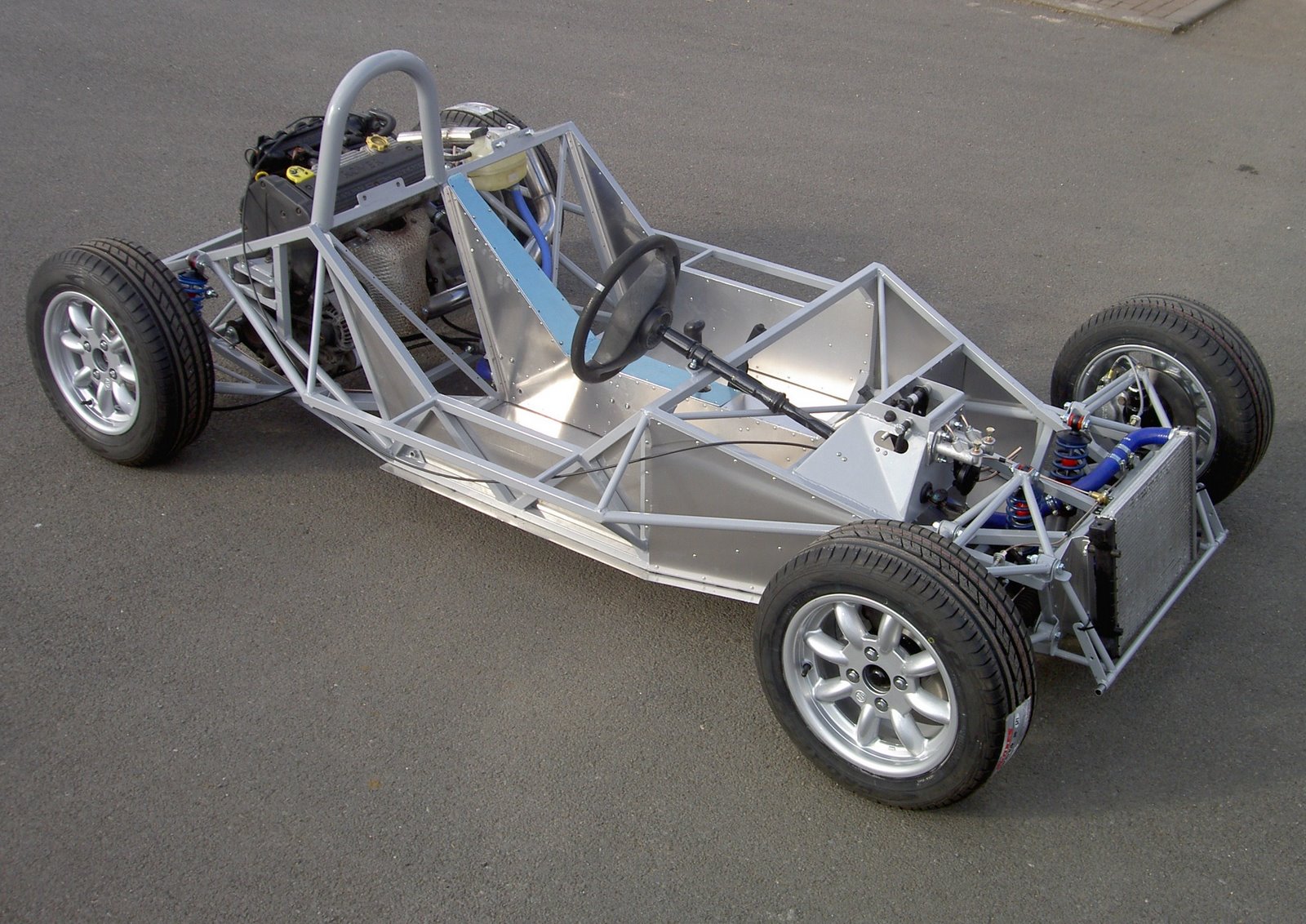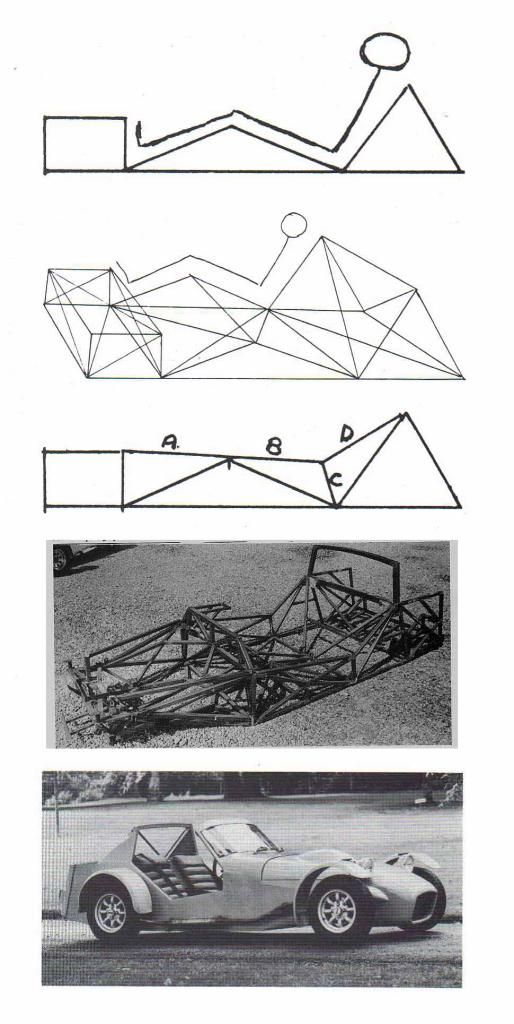If you look at my chassis as it was being strength tested, you can see where I've added 125mm wide side beams to replace the torsional strength lost from deleting the centre tunnel.
Hope this is helpful,
Dominic
[Edited on 29/5/2016 by TheGecko]

Im just about to start on my build and plan to use a rear engine configuration. This will mean I won't need the transmission tunnel. Is there any advice other members can give concerning chassis rigidity if I omit this?
quote:
Originally posted by Jomac
Is there any advice other members can give concerning chassis rigidity if I omit this?


Have you seen the Midlana. I've only seen a couple mid / rear engine 7esq cars. The Midlana is probably the best looking and comes as a book with
plans like the original. It is a fairish investment just for a read though.
It uses a full cage.
[Edited on 27/5/16 by big_wasa]
full cage may solve the ridgidity issue but i wouldnt build a super car on untested chassis builds...
I disagree with the previous to some extent, it is possible to get a rigid chassis without extensive construction down the middle.
One need only look at the Sylva Riot to see what is possible, early Riots in particular, didn't have extensive triangulation, later ones did.
Sylva Riots certainly didn't lack rigidity, especially after the adoption of side bars running across the roll hoop to the front scuttle. They
weren't wide, which also helped, the cars weren't designed for the morbidly obese (later ones were), and very well over-engineered without
being too excessive. In my opinion, a delightful piece of simple design.
The MEV Rocket? Correct me if wrong (I usually am, it's an age thing), but I remember seeing that when it came out with not a lot down the middle
- nothing in fact.
Also, unless you're thinking of ruining the thing with an entirely inappropriate engine, something from a 1000cc bike will help packaging and
performance no end.
quote:
Originally posted by motorcycle_mayhem
...it is possible to get a rigid chassis without extensive construction down the middle.

Having gone the self design route, you will probably need some sort of tunnel to carry fuel, electricity, hydraulics, water etc. If it's there, it might as well be structural!
You can read about my middy project in my buikd thread here.
If you look at my chassis as it was being strength tested, you can see where I've added 125mm wide side beams to replace the torsional strength
lost from deleting the centre tunnel.
Hope this is helpful,
Dominic
[Edited on 29/5/2016 by TheGecko]
The centre tunnel in a 7 does very little for beam or torsion. Anyone who can do the numbers will tell you fairly quickly and somewhere on this forum
is the FEA to prove it as well.
Have a walk down the pitlane at an LMP type event, no tunnels in those. However, they do put substantial structures at the sides, where the material
will do the most good. Polar moments and all that stuff.
The wide side on the Gecko thing is a good halfway solution, but a full box, properly triangulated, will do everything needed. Better still to put a
roll cage around the cockpit, and pick up big amounts of beam and torsion strength.
So, leave out the centre tunnel, it's not needed, but place the material you would have wasted, out on the sides, and enjoy a roomier cockpit.

Cheers,
Nev.
Thanks for the interesting info guys, certainly a lot to ponder on. If i had to retain the centre tunnel and use it as suggested for cables etc, i could be tempted to reduce the height of it a little. I've done some quick calculations and measurements of the donor engine and subframe, and being a small engine and box (505cc and 20hp) i think i can accommodate the whole unit quite nicely in what is effectively the boot space. I was hoping for a flat floor as it would be easier to make and give me more room in what would be a smaller car.
quote:
Originally posted by Neville Jones
The centre tunnel in a 7 does very little for beam or torsion. Anyone who can do the numbers will tell you fairly quickly and somewhere on this forum is the FEA to prove it as well.
...leave out the centre tunnel, it's not needed...

quote:
Originally posted by Jomac...If i had to retain the centre tunnel and use it as suggested for cables etc, i could be tempted to reduce the height of it a little.
'Professor' Sam_68, Martin S seems to know it all.  Though he's not an engineer.
Though he's not an engineer.
But he's wrong. Years back, there was a lot of info here about leaving out the tunnel, as I said. Plenty of FEA about as well, other than that
stated. As it is in the book, the tunnel is ineffectual. The height of the side rails has more bearing on beam strength and deflection than anything
the tunnel could ever contribute. Area times distance squared, and all that maths. Torsion...that tunnel is so small, and so close to the centre that
it'd have to be made from 40x40x4 shs, and solidly triangulated to be anywhere near structural, and that's from practical hands on testing.
Build the tunnel from anything smaller, and book size, and you're wasting good metal and precious time. It contributes a small percentage to
beam and torsion.The tunnel can be made from 1.5mm sheet, and often was/is. When you do a torsion test, the sheet can be seen visibly twisting and
distorting.
The cars that do best in the Australian beam and torsion tests, have substantially bigger top and bottom side rails, than Book sizes, and leave the
tunnel as is or even reduced.
Chip Foose was rebuilding a Lotus on the weekend(an old episode), and that chassis could be seen, quite noticeably, twisting as they moved it about.
Chip even commented on it, and extra ali was added. That is just how good a tunnel is, compared with a proper perimeter chassis.
As I said, a cage will add huge amounts of beam and torsion strength, and for a road car, and moreso track, the safety benefits outweigh any other
consideration.
I've been involved in building a good number of customer Locost type cars in the last 30 years, and tested more than a few which were for export.
The 'soft' areas in the book are the untriangulated front panels, and the cockpit. Some solutions are as I posted above.
Not worth arguing further with people who get their knowledge from books and i'net.
Cheers,
Nev. 
[Edited on 31/5/16 by Neville Jones]
quote:
Originally posted by Neville Jones
I've been involved in building a good number of customer Locost type cars in the last 30 years


Tch Tch! Put your handbag away Mrs. Thatcher. Hissy hissy cat claws out. 



Do let us know when you're driving this supercharged beast, Martin, so we can keep well away! 
Kill yourself, but noone else please.
This thread initially was concerning a chassis for 20hp microcar, then someone started sprouting his i'net knowledge, and info cut and pasted
from the net.
So 99% of what has been said is totally irrelevant.
Hell, a go-kart chassis would be sufficient. 
So, Jomac, build your chassis from tubes at least as big as kart tubes, put some sides on to protect yourself at least a little, from side impacts, a
roll bar with braces in case you tip over, and go and have some fun!
[Edited on 31/5/16 by Neville Jones]
quote:
Originally posted by Neville Jones
Tch Tch! Put your handbag away Mrs. Thatcher. Hissy hissy cat claws out.

That sexual innuendo is not out of place with what the i'net shows about you.
Ive been playing with chalk in the driveway...
I marked out the chassis and discovered two things, the first is the chassis is a little long for the size of wheels and the space for the engine. I
either increase the size of the wheels to keep things in proportion, or reduce the size to get the same effect.
The other is the fuel tank. In the original car the tank sits just behind the drivers seat below floor level. The side sills hang down hiding the tank
from view from the side, but with this frame and body the tank would be visible and an eyesore, so i have two choices. I either make a custom tank
that sits in its own frame for protection, in between the drivers seat and the engine, or i mount the tank under the front bonnet, are these
permissable?
quote:I think the next thing you have to do is get a copy of the sva/ iva manuals,
are these permissable?